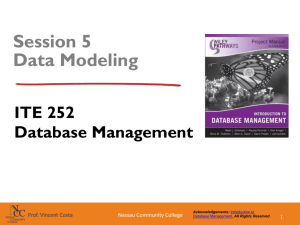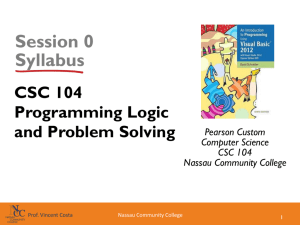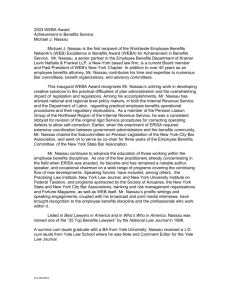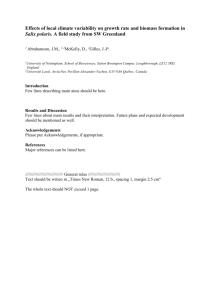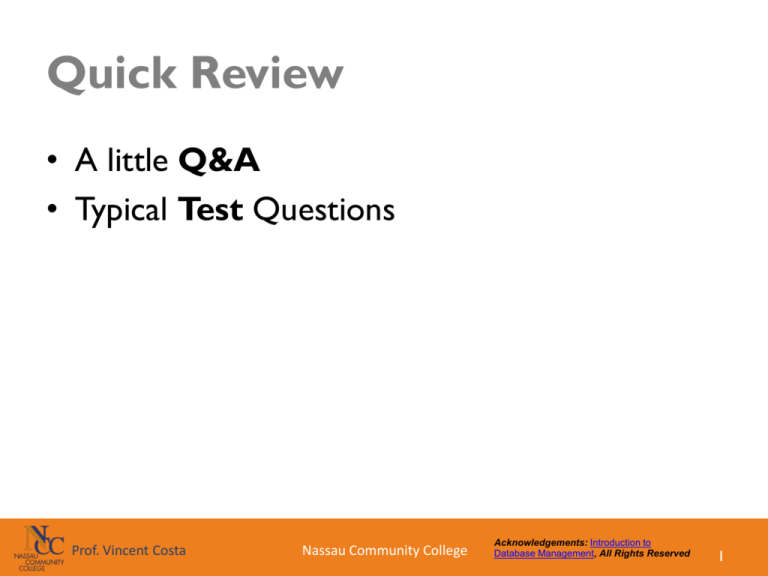
Quick Review
• A little Q&A
• Typical Test Questions
international, open membership, notfor-profit technology standards
consortium.
Prof. Vincent Costa
Nassau Community College
Acknowledgements: Introduction to
Database Management, All Rights Reserved
1
Q &A
• The terms data and information mean the same
thing.True or False?
international, open membership, notfor-profit technology standards
consortium.
Prof. Vincent Costa
Nassau Community College
Acknowledgements: Introduction to
Database Management, All Rights Reserved
2
Q &A
• The terms data and information mean the same
thing.True or False?
international, open membership, notfor-profit technology standards
consortium.
Prof. Vincent Costa
Nassau Community College
Acknowledgements: Introduction to
Database Management, All Rights Reserved
3
Q &A
What is a database management system?
a) an organization responsible for database
maintenance and administration
b) specialized software designed to implement,
international, open membership, notsupport, for-profit
and maintain
databases
technology
standards
c) a manualconsortium.
method of record-keeping phased out
with the introduction of computers
d) an end-user application designed to give users
access to data
Prof. Vincent Costa
Nassau Community College
Acknowledgements: Introduction to
Database Management, All Rights Reserved
4
Q &A
What is a database management system?
a) an organization responsible for database
maintenance and administration
b) specialized software designed to
implement,
support,
and maintain
international,
open membership,
notfor-profit technology standards
databases
c) a manualconsortium.
method of record-keeping phased out
with the introduction of computers
d) an end-user application designed to give users
access to data
Prof. Vincent Costa
Nassau Community College
Acknowledgements: Introduction to
Database Management, All Rights Reserved
5
Q &A
Which statement best describes the role of data in
business?
a) Data collection and organization is a lowpriority effort with few benefits for a business.
b) Data is important
in notthe information
international, to
openbusiness
membership,
for-profit
technology
technology
sector
only. standards
consortium.
c) All businesses
freely share data about their
customers in a cooperative environment.
d) Data can provide a competitive advantage in
hotly contested industries.
Prof. Vincent Costa
Nassau Community College
Acknowledgements: Introduction to
Database Management, All Rights Reserved
6
Q &A
Which statement best describes the role of data in
business?
a) Data collection and organization is a lowpriority effort with few benefits for a business.
b) Data is important
in notthe information
international, to
openbusiness
membership,
for-profit
technology
technology
sector
only. standards
consortium.
c) All businesses
freely share data about their
customers in a cooperative environment.
d) Data can provide a competitive advantage
in hotly contested industries.
Prof. Vincent Costa
Nassau Community College
Acknowledgements: Introduction to
Database Management, All Rights Reserved
7
Q &A
• A good place for identifying the starting point
for data collection is an organization’s core
business. True or False?
international, open membership, notfor-profit technology standards
consortium.
Prof. Vincent Costa
Nassau Community College
Acknowledgements: Introduction to
Database Management, All Rights Reserved
8
Q &A
• A good place for identifying the starting point
for data collection is an organization’s core
business. True or False?
international, open membership, notfor-profit technology standards
consortium.
Prof. Vincent Costa
Nassau Community College
Acknowledgements: Introduction to
Database Management, All Rights Reserved
9
Q &A
• Raw data is just as useful and valuable as
organized data. True or False?
international, open membership, notfor-profit technology standards
consortium.
Prof. Vincent Costa
Nassau Community College
Acknowledgements: Introduction to
Database Management, All Rights Reserved
10
Q &A
• Raw data is just as useful and valuable as
organized data. True or False?
international, open membership, notfor-profit technology standards
consortium.
Prof. Vincent Costa
Nassau Community College
Acknowledgements: Introduction to
Database Management, All Rights Reserved
11
Q &A
For what purpose are authentication methods
implemented?
a) to verify users before allowing access to data
international,
open
membership,
notb) to set access
limits
through
defined
for-profit technology standards
permissions
consortium.
c) to provide physical security for critical data
d) to maintain data organization
Prof. Vincent Costa
Nassau Community College
Acknowledgements: Introduction to
Database Management, All Rights Reserved
12
Q &A
For what purpose are authentication methods
implemented?
a. to verify users before allowing access to
data international, open membership, notfor-profit technology standards
b. to set access
limits through defined
consortium.
permissions
c. to provide physical security for critical data
d. to maintain data organization
Prof. Vincent Costa
Nassau Community College
Acknowledgements: Introduction to
Database Management, All Rights Reserved
13
Q &A
Database backups are an example of which of
the following?
a. data organization
international, open membership, notb. access security
for-profit technology standards
c. physical consortium.
security
d. user access methods
Prof. Vincent Costa
Nassau Community College
Acknowledgements: Introduction to
Database Management, All Rights Reserved
14
Q &A
Database backups are an example of which of
the following?
a. data organization
international, open membership, notb. access security
for-profit technology standards
c. physicalconsortium.
security
d. user access methods
Prof. Vincent Costa
Nassau Community College
Acknowledgements: Introduction to
Database Management, All Rights Reserved
15
Session 2
Database Concepts
(Nuts & Bolts)
ITE 252 international, open membership, notfor-profit technology standards
Database
Management
consortium.
Prof. Vincent Costa
Nassau Community College
Acknowledgements: Introduction to
Database Management, All Rights Reserved
16
Database Characteristics
•
•
•
•
Ordered collections
Contain related or linked data elements
Designed for specific information needs
Shared, so groups can collaborate
Prof. Vincent Costa
Nassau Community College
Acknowledgements: Introduction to
Database Management, All Rights Reserved
17
Database Characteristics
Prof. Vincent Costa
Nassau Community College
Acknowledgements: Introduction to
Database Management, All Rights Reserved
18
Database Concepts
• Key concepts and terminology:
– Data repository: Storage unit where files are kept
– Data dictionary: Contains the data element structures
and the relationships. Sometime called data catalog
international,
not- Oralce
– Database
software:open
SQLmembership,
Server, MySQL,
for-profit technology standards
– Data abstraction:
consortium. Ways of looking at data (views). Hide
complexities
– Data access: Read, Add, Update, Delete (CRUD)
– Transaction support: Series of statements or commands
that execute as a group
Prof. Vincent Costa
Nassau Community College
Acknowledgements: Introduction to
Database Management, All Rights Reserved
19
Types of Databases
international, open membership, notfor-profit technology standards
consortium.
Prof. Vincent Costa
Nassau Community College
Acknowledgements: Introduction to
Database Management, All Rights Reserved
20
Implementation Models
• Two main models:
– Centralized:
• Single, centrally located database server
– Distributed model:
international, open membership, not• Multiple
servers
with datastandards
spread across servers
for-profit
technology
consortium.
Prof. Vincent Costa
Nassau Community College
Acknowledgements: Introduction to
Database Management, All Rights Reserved
21
Database Models
• Describe organization of data
• Main database models:
–
–
–
–
–
Hierarchical
Network
international, open membership, notRelationalfor-profit technology standards
consortium.
Object-oriented
Hybrid object-relational
Prof. Vincent Costa
Nassau Community College
Acknowledgements: Introduction to
Database Management, All Rights Reserved
22
Hierarchical Database Model
• Hierarchical data organization
• Root data segment: Data segment at top
level
• Parent-child relationship: Relationship
between pair of data structures at adjacent
levels
Prof. Vincent Costa
Nassau Community College
Acknowledgements: Introduction to
Database Management, All Rights Reserved
23
Hierarchical Database Model
Prof. Vincent Costa
Nassau Community College
Acknowledgements: Introduction to
Database Management, All Rights Reserved
24
Network Database Model
• Doesn’t force data into hierarchical levels
• Owner/Member relationships:
– Owner record type
– Member record type
• Each owner may have one or more
member types
• Each member type and corresponding owner
record type form set, which represents
relationship
Prof. Vincent Costa
Nassau Community College
Acknowledgements: Introduction to
Database Management, All Rights Reserved
25
Network Database Model
Prof. Vincent Costa
Nassau Community College
Acknowledgements: Introduction to
Database Management, All Rights Reserved
26
Relational Database Model
• Table: Fundamental object of relational
database
– Structure: Rows and columns
– Represents one entity described by attributes
• Rows: Unique instances or records of entity
• Columns: Store attribute data
• Primary key: Enforces uniqueness for each
record
• Foreign keys: Define relationships between
tables
– May be primary keys or other unique columns
Prof. Vincent Costa
Nassau Community College
Acknowledgements: Introduction to
Database Management, All Rights Reserved
27
Relational Database Model
Prof. Vincent Costa
Nassau Community College
Acknowledgements: Introduction to
Database Management, All Rights Reserved
28
Object-Oriented Database Model
• Evolved to address some of limiting features of
relational databases
• Enables more precise, truer depiction of real-world
objects
international, open membership, not• Support for
large
quantities
of binary data,
for-profit
technology
standards
consortium.files
such as multimedia
Prof. Vincent Costa
Nassau Community College
Acknowledgements: Introduction to
Database Management, All Rights Reserved
29
Object-Relational Database Model
• Object-relational database management
systems (ORDBMS):
– Combine:
• Ability of object technology to handle advanced
relationship types
• Data integrity, reliability, and recovery features of
relational models
– Most popular and powerful of modern database
system applications
• Oracle, Microsoft SQL Server
Prof. Vincent Costa
Nassau Community College
Acknowledgements: Introduction to
Database Management, All Rights Reserved
30
Object-Relational Database Table
Prof. Vincent Costa
Nassau Community College
Acknowledgements: Introduction to
Database Management, All Rights Reserved
31
Database Environment
• Database environment responsible for:
–
–
–
–
Data storage
Data retrieval
Data manipulation
Range of support activities
Prof. Vincent Costa
Nassau Community College
Acknowledgements: Introduction to
Database Management, All Rights Reserved
32
Database Components
• Database environment components:
Data repository
DBMS
Hardware
Procedures
Application software
Practitioners
Prof. Vincent Costa
Data dictionary
Systems software
Network
Application interfaces
Front-end tools
Users
Nassau Community College
Acknowledgements: Introduction to
Database Management, All Rights Reserved
33
Database Components
Prof. Vincent Costa
Nassau Community College
Acknowledgements: Introduction to
Database Management, All Rights Reserved
34
Hardware Components
• Hardware:
– Individual computers
– Network infrastructure
• Traditional database deployment:
– Mainframe or mini-computer, or
– Client/server configuration
• PCs as both database servers and clients
Prof. Vincent Costa
Nassau Community College
Acknowledgements: Introduction to
Database Management, All Rights Reserved
35
Hardware Components
Prof. Vincent Costa
Nassau Community College
Acknowledgements: Introduction to
Database Management, All Rights Reserved
36
Hardware Components
• Manufacturer requirements for DBMS:
– Minimum hardware requirements
– Recommended configuration
• Important PC hardware components:
– Processor
international, open membership, not– Main memory
and memory
buffers
for-profit
technology
standards
– Secondary
or nonvolatile storage devices
consortium.
• Storage considerations:
– Speed and capacity
– Fault-tolerance (e.g. RAID configurations)
– Backups
Prof. Vincent Costa
Nassau Community College
Acknowledgements: Introduction to
Database Management, All Rights Reserved
37
Software Requirements
• Software components:
– DBMS:
• Specialized database management system
– Operating system software:
international, open membership, not• Layer for-profit
betweentechnology
applications
and hardware
standards
consortium.
• Manages
hardware, processes, memory, files, I/O
devices, network control and communications, and fault
detection and recovery
Prof. Vincent Costa
Nassau Community College
Acknowledgements: Introduction to
Database Management, All Rights Reserved
38
Software Requirements
• Software components:
– Application programs
• Database application software
– Server applications
international,
– Client
applicationsopen membership, notfor-profit
technology
standards
– Server
and client
applications
running as distributed
consortium.
application
Prof. Vincent Costa
Nassau Community College
Acknowledgements: Introduction to
Database Management, All Rights Reserved
39
DBMS Components
•
•
•
•
•
•
Database engine
Data dictionary
Query processor
Forms generator
Report writer
Other utility tools and interface modules
Prof. Vincent Costa
Nassau Community College
Acknowledgements: Introduction to
Database Management, All Rights Reserved
40
DBMS Components
Prof. Vincent Costa
Nassau Community College
Acknowledgements: Introduction to
Database Management, All Rights Reserved
41
Users and Practitioners
• Users:
–
–
–
–
–
Casual users
Regular users
Power users
Specialized users
Individual users
Prof. Vincent Costa
• Practitioners:
–
–
–
–
–
–
Business analysts
Data modelers
Database designers
Systems analysts
Programmer analysts
Database
administrators
Nassau Community College
Acknowledgements: Introduction to
Database Management, All Rights Reserved
42
Users and Practitioners
Prof. Vincent Costa
Nassau Community College
Acknowledgements: Introduction to
Database Management, All Rights Reserved
43
Procedures
• Proper methods and procedures:
– Essential to maintaining database and ensuring consistency
• Procedures may be automated or manual, and
include:
–
–
–
–
–
–
Usage
international, open membership, notQueries and
reports
for-profit
technology standards
Routine maintenance
consortium.
Structure change management
Backup and recovery
Database tuning
Prof. Vincent Costa
Nassau Community College
Acknowledgements: Introduction to
Database Management, All Rights Reserved
44
Summary
• Types of databases include production,
decision-support, and mass deployment
databases.
• Databases are implemented using centralized
or distributed model.
international, open membership, not• Database
models are hierarchical, network,
for-profit technology standards
relational,
object-oriented, or hybrid
consortium.
object-relational.
• The database environment includes
hardware, software, and DBMS components as
well as people (users and practitioners) and
procedures.
Prof. Vincent Costa
Nassau Community College
Acknowledgements: Introduction to
Database Management, All Rights Reserved
45
Key Terms
• Attribute
• Binary large object (BLOB)
data type
• Centralized model
• Concurrency control
• CRUD
• Data abstraction
• Database engine
• Database management
system (DBMS)
• Database practitioner
Prof. Vincent Costa
Database software
Data catalog
Data dictionary
Data repository
Data type
Decision support database
Direct memory access
(DMA)
• Distributed model
• Entity
•
•
•
•
•
•
•
Nassau Community College
Acknowledgements: Introduction to
Database Management, All Rights Reserved
46
Key Terms
• Foreign key
• Forms generator
• Heterogeneous data
environment
• Hierarchical database model
• Main memory
• Memory buffer
• Metadata
• Network database model
• Nonvolatile storage
Prof. Vincent Costa
• Object-oriented database
model
• Object-relational database
model
• Operating system software
• Physical data pointer
• Primary key
• Production database
• Query
• Query optimizer
Nassau Community College
Acknowledgements: Introduction to
Database Management, All Rights Reserved
47
Key Terms
• Query processor
• RAID
• Relational database model
Relational database
• Relationship
• Report writer
• Schema
Prof. Vincent Costa
• Secondary storage
• Structured Query Language
(SQL)
• Table
• Transaction
• Unified Modeling Language
(UML)
• View
Nassau Community College
Acknowledgements: Introduction to
Database Management, All Rights Reserved
48
Key Terms
•
•
•
•
•
•
•
•
•
Attribute - Information describing a data entity.
Binary large object (BLOB) data type - Relational data type used to store large blocks
for binary data.
Centralized model - Database deployment model characterized by a single database
server in a central location and accessed by local and remote users.
Concurrency control - Database control over data access as a way of prevent errors that
can occur when multiple users try to modify the same data at the same time.
CRUD - Acronym for create, read, update, and delete, the standard data processes
international, open membership, notsupported by a database.
for-profit
Data abstraction
- A way to technology
look at data thatstandards
breaks it down into is basic components
and groups the components
to support different ways of looking at the data.
consortium.
Database engine - Core DBMS component responsible for data retrieval and modification,
coordinating other DBMS component actions, providing an interface with the data user, and
interfacing with the platform operating system.
Database management system (DBMS) - Software that supports storing, retrieving, and
updating data in a database.
Database practitioner - Information Technology personnel responsible for designing,
creating, and maintaining databases.
Prof. Vincent Costa
Nassau Community College
Acknowledgements: Introduction to
Database Management, All Rights Reserved
49
Key Terms
•
•
•
•
•
•
•
•
Database software - See database management system (DBMS).
Data dictionary - Database component that describes data structures and data locations.
Also called the data catalog.
Data repository - Refers to the data storage unit where physical data files are kept.
Data type - A way of describing the kind of data that can be stored in a column or a
variable.
Decision support
database - A database
to support
advanced data mining
international,
open designed
membership,
notactivities and provide support for strategic decision making.
for-profit technology standards
Direct memory access (DMA) - Access channel that enables devices such as disk drives
consortium.
and network adapters
to directly access (write to and read from) the computer’s main
memory.
Distributed model - Database deployment model characterized by multiple database
servers, typically deployed in different physical locations.
Entity - Refers to something having a distinct existence. In the context of database
technologies, refers to the items that can be described and tracked in the database.
Prof. Vincent Costa
Nassau Community College
Acknowledgements: Introduction to
Database Management, All Rights Reserved
50
Key Terms
•
•
•
•
•
•
•
•
Foreign key - Relational database object used to define and maintain relationships between
tables.
Forms generator - DBMS component used to design forms. Most commonly used to
design data input and data presentation forms.
Hierarchical database model - Database model based on a hierarchical (parent/child)
data organization. This is primarily a legacy mainframe database model.
Main memory - Provides temporary storage of data and programs
international, open membership, notMemory buffer - Dedicated area in main memory used for temporary data storage.
for-profit technology standards
Metadata - Data about data, or the data describing a database and database objects.
consortium.
Network database model - Database model based on data organization supporting
flexible owner/member relationships between data entities. This is primarily a legacy
mainframe database model.
Nonvolatile storage - Storage media that continues to hold the data it contains when
power is lost or the computer is turned off. The most common example is disk drives.
Prof. Vincent Costa
Nassau Community College
Acknowledgements: Introduction to
Database Management, All Rights Reserved
51
Key Terms
•
•
•
•
•
•
•
•
Object-oriented database model - Database model where entities are treated as objects,
which are individual items that can be defined and described more completely than in a relational
model.
Object-relational database model - Hybrid database model based on the relational
model, but integrating features and functionality from the object-oriented model.
Operating system software - Software that controls the computer hardware, provides an
interface to the user, and provides an environment in which applications can run.
international, open membership, notPrimary key - Database object used to enforce uniqueness in a table
for-profit
technology
Production database
- Database
that providesstandards
support for day-to-day business activities.
consortium.
Query - Executable
statement written in a DBMS language and typically used to retrieve or
manipulate data.
Query processor - DBMS component responsible for parsing, optimizing, and compiling
queries for execution. Also known as a query optimizer.
RAID - Redundant Array or Inexpensive (or Independent) Disks, disk configurations
commonly used with database systems that provide enhanced performance and, in most
configurations, fault tolerance.
Prof. Vincent Costa
Nassau Community College
Acknowledgements: Introduction to
Database Management, All Rights Reserved
52
Key Terms
•
•
•
•
•
•
•
•
•
•
•
Relational database model - Database model based on entities that are associated with
each other through relationships.
Relational database - Database based on the relational model.
Relationship - An association defined and established between two data entities.
Report writer - DBMS component responsible for designing and processing reports.
Schema - Metadata used to describe database objects.
Secondary storage
- Nonvolatile data
storage
such as disk and
tape drives.
international,
open
membership,
notStructured Query
Languagetechnology
(SQL) - The standard
language for relational DBMSs.
for-profit
standards
Table - Fundamental
database object in the relational database model where entities are
consortium.
described as rows and columns.
Transaction - A series of statements or commands that execute as a group. All of the
statements must either run successfully or all must be rolled back, as if they were never run
Unified Modeling Language (UML) - Language created to design and model objectoriented systems, including object-oriented databases.
View - Relational database model database object that provides custom data retrieval.
Prof. Vincent Costa
Nassau Community College
Acknowledgements: Introduction to
Database Management, All Rights Reserved
53
Quick Review
• A little Q&A
• Typical Test Questions
international, open membership, notfor-profit technology standards
consortium.
Prof. Vincent Costa
Nassau Community College
Acknowledgements: Introduction to
Database Management, All Rights Reserved
54
Q &A
• Which of the following relate to storing and
managing data structure information?
a) data repository
international, open membership, notb) data abstraction
for-profit technology standards
consortium.
c) data dictionary
d) data access
Prof. Vincent Costa
Nassau Community College
Acknowledgements: Introduction to
Database Management, All Rights Reserved
55
Q &A
• Which of the following relate to storing and
managing data structure information?
a) data repository
international, open membership, notb) data abstraction
for-profit technology standards
c) data consortium.
dictionary
d) data access
Prof. Vincent Costa
Nassau Community College
Acknowledgements: Introduction to
Database Management, All Rights Reserved
56
Q &A
• Which of the following statements correctly
describes a transaction?
a) All statements in a transaction must be
completed or rolled back as a group.
international, open membership, notb) A transaction
must consist
of a single
for-profit technology
standards
consortium.
executable
statement.
c) If an error occurs during processing, a
transaction leaves data in an inconsistent
state.
Prof. Vincent Costa
Nassau Community College
Acknowledgements: Introduction to
Database Management, All Rights Reserved
57
Q &A
• Which of the following statements correctly
describes a transaction?
a) All statements in a transaction must be
completed or rolled back as a group.
international, open membership, notb) A transaction
must consist
of a single
for-profit technology
standards
consortium.
executable
statement.
c) If an error occurs during processing, a
transaction leaves data in an inconsistent
state.
Prof. Vincent Costa
Nassau Community College
Acknowledgements: Introduction to
Database Management, All Rights Reserved
58
Q &A
• Which of the following correctly lists the
words making up the abbreviation CRUD?
a) consistency, redundancy, utility, data store
international,
open membership,
b) create,
read, update,
delete notfor-profit technology standards
consortium.
c) columns,
rows, users, data
d) create, reply, understand, distribute
Prof. Vincent Costa
Nassau Community College
Acknowledgements: Introduction to
Database Management, All Rights Reserved
59
Q &A
• Which of the following correctly lists the
words making up the abbreviation CRUD?
a) consistency, redundancy, utility, data store
international,
open membership,
notb) create,
read, update,
delete
for-profit technology standards
consortium.
c) columns,
rows, users, data
d) create, reply, understand, distribute
Prof. Vincent Costa
Nassau Community College
Acknowledgements: Introduction to
Database Management, All Rights Reserved
60
Q &A
• In the hierarchical model, a parent can have
multiple children and a child can have multiple
parents.True or False?
international, open membership, notfor-profit technology standards
consortium.
Prof. Vincent Costa
Nassau Community College
Acknowledgements: Introduction to
Database Management, All Rights Reserved
61
Q &A
• In the hierarchical model, a parent can have
multiple children and a child can have multiple
parents.True or False?
international, open membership, notfor-profit technology standards
consortium.
Prof. Vincent Costa
Nassau Community College
Acknowledgements: Introduction to
Database Management, All Rights Reserved
62
Q &A
• Which database model is most commonly
used in modern database design?
a) hierarchical model
international,
b) network
modelopen membership, notfor-profit technology standards
consortium.
c) object-oriented
model
d) relational model
Prof. Vincent Costa
Nassau Community College
Acknowledgements: Introduction to
Database Management, All Rights Reserved
63
Q &A
• Which database model is most commonly
used in modern database design?
a) hierarchical model
international,
b) network
modelopen membership, notfor-profit technology standards
consortium.
c) object-oriented
model
d) relational model
Prof. Vincent Costa
Nassau Community College
Acknowledgements: Introduction to
Database Management, All Rights Reserved
64
Q &A
• Which data model is able to most completely
describe complex data types and real-world
entities?
international,
open membership, nota) hierarchical
model
for-profit technology standards
b) network
model
consortium.
c) object-oriented model
d) relational model
Prof. Vincent Costa
Nassau Community College
Acknowledgements: Introduction to
Database Management, All Rights Reserved
65
Q &A
• Which data model is able to most completely
describe complex data types and real-world
entities?
international,
open membership, nota) hierarchical
model
for-profit technology standards
b) network
model
consortium.
c) object-oriented model
d) relational model
Prof. Vincent Costa
Nassau Community College
Acknowledgements: Introduction to
Database Management, All Rights Reserved
66
Q &A
• Hardware and file management are the
responsibility of which of the following?
a) application software
international,
open membership, notb) operating
system
for-profit technology standards
consortium.
c) database
d) DBMS
Prof. Vincent Costa
Nassau Community College
Acknowledgements: Introduction to
Database Management, All Rights Reserved
67
Q &A
• Hardware and file management are the
responsibility of which of the following?
a) application software
international,
open membership, notb) operating
system
for-profit technology standards
consortium.
c) database
d) DBMS
Prof. Vincent Costa
Nassau Community College
Acknowledgements: Introduction to
Database Management, All Rights Reserved
68
Q &A
• Which of the following would typically be
supported by automatic periodic procedures?
a) data backup
international,
b) database
tuningopen membership, notfor-profit technology standards
consortium.
c) routine
maintenance
d) all of the above
Prof. Vincent Costa
Nassau Community College
Acknowledgements: Introduction to
Database Management, All Rights Reserved
69
Q &A
• Which of the following would typically be
supported by automatic periodic procedures?
a) data backup
international,
b) database
tuningopen membership, notfor-profit technology standards
consortium.
c) routine
maintenance
d) all of the above
Prof. Vincent Costa
Nassau Community College
Acknowledgements: Introduction to
Database Management, All Rights Reserved
70
Q &A
• What is SQL?
a) a specialized DBMS product
b) the standard language for relational DBMSs
international, open membership, notc) an acronym
to the DBMS query
for-profit referring
technology standards
consortium.
processor
d) a popular third-party forms generator
Prof. Vincent Costa
Nassau Community College
Acknowledgements: Introduction to
Database Management, All Rights Reserved
71
Q &A
• What is SQL?
a) a specialized DBMS product
b) the standard language for relational
international, open membership, notDBMSs
for-profit technology standards
consortium.
c) an acronym
referring to the DBMS query
processor
d) a popular third-party forms generator
Prof. Vincent Costa
Nassau Community College
Acknowledgements: Introduction to
Database Management, All Rights Reserved
72
Q &A
• Secondary storage refers to which of the
following?
a) local hard disk
international, open
membership, notb) main computer
memory
for-profit technology standards
consortium.
c) memory
buffers
d) processor cache
Prof. Vincent Costa
Nassau Community College
Acknowledgements: Introduction to
Database Management, All Rights Reserved
73
Q &A
• Secondary storage refers to which of the
following?
a) local hard disk
international, open
membership, notb) main computer
memory
for-profit technology standards
consortium.
c) memory
buffers
d) processor cache
Prof. Vincent Costa
Nassau Community College
Acknowledgements: Introduction to
Database Management, All Rights Reserved
74
Important Links
• Object Database – Wikipedia definition
• Computer Scientists and Database Administrators –
Description, Job Outlook, Pay from the Bureau of
Labor Statistiics
international, open membership, not• SQL History
and Background
- Wikipedia defintion
for-profit
technology standards
consortium.
• Introduction
to Relational Databases – gentle
introduction from the database journal
Prof. Vincent Costa
Nassau Community College
Acknowledgements: Introduction to
Database Management, All Rights Reserved
75
Homework
• Read Chapter Two, pp.24-54
international, open membership, notfor-profit technology standards
consortium.
Prof. Vincent Costa
Nassau Community College
Acknowledgements: Introduction to
Database Management, All Rights Reserved
76

